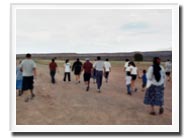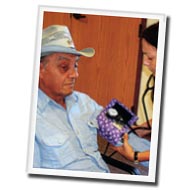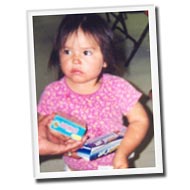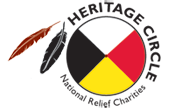| Home | About Us | Services | Success Stories | How to Help | Resources |

Services: Health
 Poverty and lack of education about health problems and prevention result in a shorter life expectancy and higher rates of disease among Native Americans. According to Indian Country Today (9/15/04), per capita annual expenditure for health care is $1,900 for American Indians, compared to $3,800 for federal prisoners and $5,600 for the general population.
Poverty and lack of education about health problems and prevention result in a shorter life expectancy and higher rates of disease among Native Americans. According to Indian Country Today (9/15/04), per capita annual expenditure for health care is $1,900 for American Indians, compared to $3,800 for federal prisoners and $5,600 for the general population.
The Centers for Disease Control and the Indian Health Service have said Indians and Alaskan Natives have a life expectancy that is six years less than other populations in the country. (August 8-15, 2003, Lakota Journal).
On reservations there are few medical facilities; and those that do exist are typically understaffed and have inadequate, outdated equipment. Unemployment rates are very high on reservations and residents lack both transportation and income to cover travel expenses. It is very difficult for residents to travel great distances to get specialized care.
 CIN’s Health Programs aim both to promote a healthy lifestyle by educating Native Americans about the importance of good nutrition and exercise. CIN Programs also encourage healthy habits through the use of incentives such as first aid kits, bandages, non-prescription medications, and lotions that are not widely available on reservations and are typically too expensive for residents’ limited budgets.
CIN’s Health Programs aim both to promote a healthy lifestyle by educating Native Americans about the importance of good nutrition and exercise. CIN Programs also encourage healthy habits through the use of incentives such as first aid kits, bandages, non-prescription medications, and lotions that are not widely available on reservations and are typically too expensive for residents’ limited budgets.
CIN Health Programs include:
Health education classes.
More Native Americans participate in health education classes and programs and learn about the importance of good nutrition, and exercise, to prevent health problems, and how to deal with diseases if they have already occurred.
Health Fairs.
More community members attend health fairs and learn about health resources in their communities, participate in health screenings, and get referrals to the appropriate resources if they need further medical attention. CIN hopes that these health screenings will help to catch diseases early so that patients can seek the medical treatment they need.
Exercise classes and walking clubs.
Residents learn how to exercise and participate in exercise classes and clubs.
Monitoring blood pressure, blood sugar, weight, and cholesterol.
Increased numbers of patients who participate in health screenings such as blood pressure, blood sugar, cholesterol, weights, etc.
 Incentives for making and keeping medical appointments and for complying with restrictive programs. Many of our Program Partners work with us to keep diabetes patients healthy and active. Patients are encouraged by incentives to make the extra effort required to find transportation, wait hours and hours to see a doctor, and to comply with difficult regimes (such as for diabetics) and restrictions (such as reduced fluid intake).
Incentives for making and keeping medical appointments and for complying with restrictive programs. Many of our Program Partners work with us to keep diabetes patients healthy and active. Patients are encouraged by incentives to make the extra effort required to find transportation, wait hours and hours to see a doctor, and to comply with difficult regimes (such as for diabetics) and restrictions (such as reduced fluid intake).
One program that brings it all together is the Navajo Nation Diabetes Project in Kayenta, Arizona. The Diabetes Project sponsors educational programs, walks, and other community events to address the epidemic of diabetes there. Through its Program Partners there, CIN supplies care bags as incentives for elders to come in for diabetes screening.
Read the success story...
How can I help?
 Poverty and lack of education about health problems and prevention result in a shorter life expectancy and higher rates of disease among Native Americans. According to Indian Country Today (9/15/04), per capita annual expenditure for health care is $1,900 for American Indians, compared to $3,800 for federal prisoners and $5,600 for the general population.
Poverty and lack of education about health problems and prevention result in a shorter life expectancy and higher rates of disease among Native Americans. According to Indian Country Today (9/15/04), per capita annual expenditure for health care is $1,900 for American Indians, compared to $3,800 for federal prisoners and $5,600 for the general population. The Centers for Disease Control and the Indian Health Service have said Indians and Alaskan Natives have a life expectancy that is six years less than other populations in the country. (August 8-15, 2003, Lakota Journal).
On reservations there are few medical facilities; and those that do exist are typically understaffed and have inadequate, outdated equipment. Unemployment rates are very high on reservations and residents lack both transportation and income to cover travel expenses. It is very difficult for residents to travel great distances to get specialized care.
 CIN’s Health Programs aim both to promote a healthy lifestyle by educating Native Americans about the importance of good nutrition and exercise. CIN Programs also encourage healthy habits through the use of incentives such as first aid kits, bandages, non-prescription medications, and lotions that are not widely available on reservations and are typically too expensive for residents’ limited budgets.
CIN’s Health Programs aim both to promote a healthy lifestyle by educating Native Americans about the importance of good nutrition and exercise. CIN Programs also encourage healthy habits through the use of incentives such as first aid kits, bandages, non-prescription medications, and lotions that are not widely available on reservations and are typically too expensive for residents’ limited budgets. CIN Health Programs include:
Health education classes.
More Native Americans participate in health education classes and programs and learn about the importance of good nutrition, and exercise, to prevent health problems, and how to deal with diseases if they have already occurred.
Health Fairs.
More community members attend health fairs and learn about health resources in their communities, participate in health screenings, and get referrals to the appropriate resources if they need further medical attention. CIN hopes that these health screenings will help to catch diseases early so that patients can seek the medical treatment they need.
Exercise classes and walking clubs.
Residents learn how to exercise and participate in exercise classes and clubs.
Monitoring blood pressure, blood sugar, weight, and cholesterol.
Increased numbers of patients who participate in health screenings such as blood pressure, blood sugar, cholesterol, weights, etc.
 Incentives for making and keeping medical appointments and for complying with restrictive programs. Many of our Program Partners work with us to keep diabetes patients healthy and active. Patients are encouraged by incentives to make the extra effort required to find transportation, wait hours and hours to see a doctor, and to comply with difficult regimes (such as for diabetics) and restrictions (such as reduced fluid intake).
Incentives for making and keeping medical appointments and for complying with restrictive programs. Many of our Program Partners work with us to keep diabetes patients healthy and active. Patients are encouraged by incentives to make the extra effort required to find transportation, wait hours and hours to see a doctor, and to comply with difficult regimes (such as for diabetics) and restrictions (such as reduced fluid intake). One program that brings it all together is the Navajo Nation Diabetes Project in Kayenta, Arizona. The Diabetes Project sponsors educational programs, walks, and other community events to address the epidemic of diabetes there. Through its Program Partners there, CIN supplies care bags as incentives for elders to come in for diabetes screening.
Read the success story...
How can I help?





